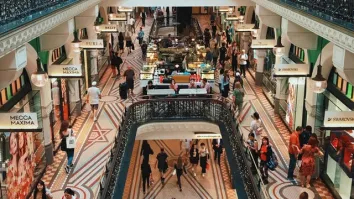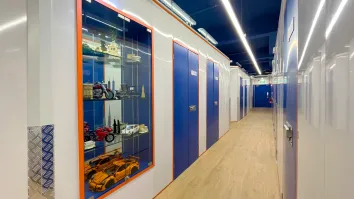
What's driving the growth of the logistics sector in APAC?
The e-commerce boom is one of the major growth drivers.
The logistics sector has remained resilient despite the uncertainties brought about by the ongoing pandemic. JLL outlines the major growth drivers for this sector such as e-commerce, 3PL and supply chain, and other drivers.
Here’s more from JLL:
E-commerce
Asia Pacific leads the world in terms of the adoption of technology, particularly in regards to e-commerce. The growing middle class in the region has become accustomed to e-commerce, which is furthering the demand for door-to-door deliveries and modern logistics facilities near major population centres.
Online retail sales as a proportion of total retail sales (online retail penetration) are steadily increasing in almost all global markets year-on-year. E-commerce now accounts for around 20% of all retail sales in AP as compared to 14% globally. China is already the world’s single largest e-commerce market, with retail e-commerce sales accounting for 37% of all retail sales in 2019, according to e-Marketer. This proportion is expected to rise to 64% by 2023.
With consumers increasingly using the internet and mobile devices to purchase goods, e-commerce sales have grown at a faster pace than sales in traditional brick and mortar stores. Globally, e-commerce logistics spending is expected to grow at a 2019-2024 CAGR of 15%. E-commerce is a positive tailwind for consumption-driven demand for logistics real estate. Typically, e-commerce firms use more logistics space than brick-and-mortar retailers. This is largely due to a more extensive product range, greater inventory levels, larger outbound shipping space requirements, and increased reverse logistics (process returns).
3PL and supply chain
Supply chain modernisation is adding to the growing demand for new logistics facilities. Tenants are upgrading from outdated, often small and owner-occupied facilities to newer facilities in premium locations. Simultaneously, the consolidation of logistics operations into more modern facilities is improving efficiency and reducing the overall logistics costs of tenants.
The 3PL market comprises of freight-forwarding and contract logistics. The outsourcing of transport and logistics operations (most commonly warehousing and distribution) by any company to a dedicated 3PL service provider is known as contract logistics. Globally, contract logistics accounts for about 60% of total 3PL spending, while freight forwarding accounts for about 40%. Warehousing accounts for the greatest share of global contract logistics revenue (45-55%). Transportation accounts for 35-45%, while value-added services constitute the remainder.
Growing demand from the logistics industry has supported market expansion. Over the past decade, AP logistics stock has increased by around 90 million sqm. At the same, Transport Intelligence forecasts that US$106 billion will be spent on AP contract logistics in 2020, an increase of US$55 billion in 10 years. On this very simple measure, we estimate that 1 sqm of new prime logistics space is needed to service every US$600 increase in contract logistics spending.
Future growth remains positive. Spending in the AP contract logistics industry is projected to grow at a CAGR of around 7% between 2019 and 2024, more than triple the growth rate in North America and Europe combined (2019-2024 CAGR of 1.9%). As such, there may be a need for more modern logistics providers to service the region.

Other industry drivers
The consumer and retail industries are the main drivers of the global logistics industry, accounting for around half of all contract logistics revenues.
Growth in consumer spending, particularly spending on fast moving consumer goods (FMCG), food and beverages, and apparel, is helping support demand for logistics real estate. FMCG products are often low value and are sold in very large volumes. In order to optimise transportation and inventory levels, well located large distribution facilities with high capacity are best suited for distributing these types of goods.
Logistics demand of fashion manufacturers and retailers are also becoming more sophisticated. Logistics companies are now required to undertake services such as order preparation for direct distribution, multi-country consolidation, quality control operations, and value-added services such as labelling, tagging, and co-packing.
Food and beverage
Spending on logistics from the retail industry mainly comes from the food and beverages sector, as well as fast moving consumer goods (FMCGs) including items such as toiletries, over-the-counter drugs and other consumables.
As a result of urbanisation and rising income levels, food production and distribution in the AP region is rapidly transforming from a sector dominated by family-based farms and small-scale firms to one dominated by global companies.
Food chains have become international. Major food exporters in AP include Australia, Indonesia and Thailand, with food accounting for over 10% of merchandise exports in 2018. In particular, food accounts for over 50% of New Zealand’s merchandise exports. On the other hand, East Asia is a major net importer of food (World Bank).
Moreover, quality control in terms of health and safety to consumers is becoming crucial to the food industry. This demand has pushed businesses to invest in more efficient operations, which has resulted in a more integrated food supply chains.
Healthcare/pharmaceuticals
Retail is not the only industry driving the growth in logistics spending. With its affluent but ageing population continuing to drive healthcare spending, AP will remain integral to the commercial growth prospects of multinational pharmaceutical firms.
The region is projected to see continuing growth in medicine sales, led by South and Southeast Asia, as countries like Indonesia and the Philippines get ready to follow suit on China’s implementation of universal healthcare. According to Statista, total pharmaceutical sales in AP is projected to rise from US$300 billion in 2017 to US$350 billion in 2022, a 5-year CAGR of 3.3%.
In addition, temperature-controlled healthcare products may soon make up the majority of pharmaceuticals. These specialised healthcare products require special handling, storage and transport, and will result in new service offerings from specialised logistics providers, and investment opportunities in cold chain logistics.
Technology supply chain
The growth rate in the technology sector (e.g. consumer electronics, IT, telecommunications, etc.) will be even higher than manufactured goods in general. Of particular importance is China’s role in the global supply chains of technology products.
For example, China accounted for 32% of the world’s exports and 20% of the world’s imports of office and telecom equipment in 2018. China’s exports of office and telecom equipment grew at an annual average of 5% between 2010 and 2018, and imports grew even faster at 7% during the same period. This may prove an increasingly important driver of demand for logistics real estate going forward.



















 Advertise
Advertise






